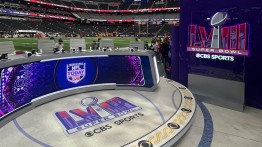Lena Imamura A’08
The Cooper Union can finally boast of a graduate in the Superbowl: Lena Imamura and her work as a neon glass designer was featured in an ad for the 2024 Superbowl edition of “That Other Pregame Show” on CBS. Between shots of San Francisco quarterback Brock Purdy and Kansas City tight end Travis Kelce, the ad shows Imamura, a 2008 graduate of Cooper’s School of Art, sporting protective glasses as she bends glass heated to more than 450 degrees. The spot’s last shot shows her finished work: the logo of “That Other Pregame Show” glistening in neon.
Imamura’s road to gridiron glory took an unconventional route, one that began even before she graduated. While at Cooper, she collaborated with friends studying engineering and architecture. “It was a secondhand education,” she said. Outside of school, she knew many people who were part of a nascent art and music scene. By her sophomore year, she was part of a collective called the Canal Chapter, an early sponsorship by Red Bull in arts and culture. The group worked and lived in a loft with wide open spaces for a variety of events. “I was programming films, music parties, residencies—that definitely was a combination of a lot of interests that I have,” she said recently.
One of the events was a music show where she met a musician who asked her to be his manager in charge of his bookings and, eventually, an investment he’d made to produce singles and shows. That project wound up coinciding with bookkeeping work she was doing with the Bruce High Quality Foundation, an art collective of Cooper Union alumni known for its critiques of the commercialization and academicization of art practices. She realized at that point that she had a real knack for both sides of creative production—the artistic and the financial.
“There aren’t many people that have both left and right brain skills—being creative and being good with numbers. That became a calling of sorts.”
Imamura founded ACCOUNTESS to help artists manage their projects and finances. “The art space is riddled with people who can’t deal with the details,” she observed. After landing several major clients, the business soon became a success. Still, she found that she wanted more of a hand in the creative part of the arts, so she sold ACCOUNTESS to The Bookkeeping Company of New York, and then went into art management.
First as controller then as managing director for the artist Vito Schnabel, she oversaw all financial activities, exhibitions and events, artist management, acquisitions and sales, catalog production, HR, and special projects. The work was largely centered on organizing site-specific exhibitions—one involved erecting a 20-foot bronze sculpture in a corn field in Long Island—to counter the traditional, white space gallery model. But the business became increasingly conventional, so after four years, she decided to move to the fundraising platform Kickstarter. “Until then, the industries that I’d touched were music, galleries, events, but I hadn’t explored tech.”
She learned a great deal about the power and potential of working at a large scale, though as she points out, Kickstarter is considered a medium-sized business. During the three years she spent at the company, she served on its executive team under the CEO and then chief of staff, a position, she says that “gave me an extraordinary perspective on that level of scale.”
Taking that wealth of experience, she co-founded her own business, GLO Studio, this time working as a neon artist who takes commissions to fashion work from neon and glass. (In 2020, she and partner Sas Simon retooled their firm to respond to requests for personal protective equipment.) Besides capitalizing on her long history merging the arts and business, GLO Studio lets Imamura realize a central belief of her practice: art should be accessible and a part of everyday life in public spaces. That means that at GLO, she doesn’t work with people simply needing a neon sign, but clients who “come to us because they want something cool, but they don’t know how to start. We can visualize and realize their ideas. And that’s been a throughline in my career.”







